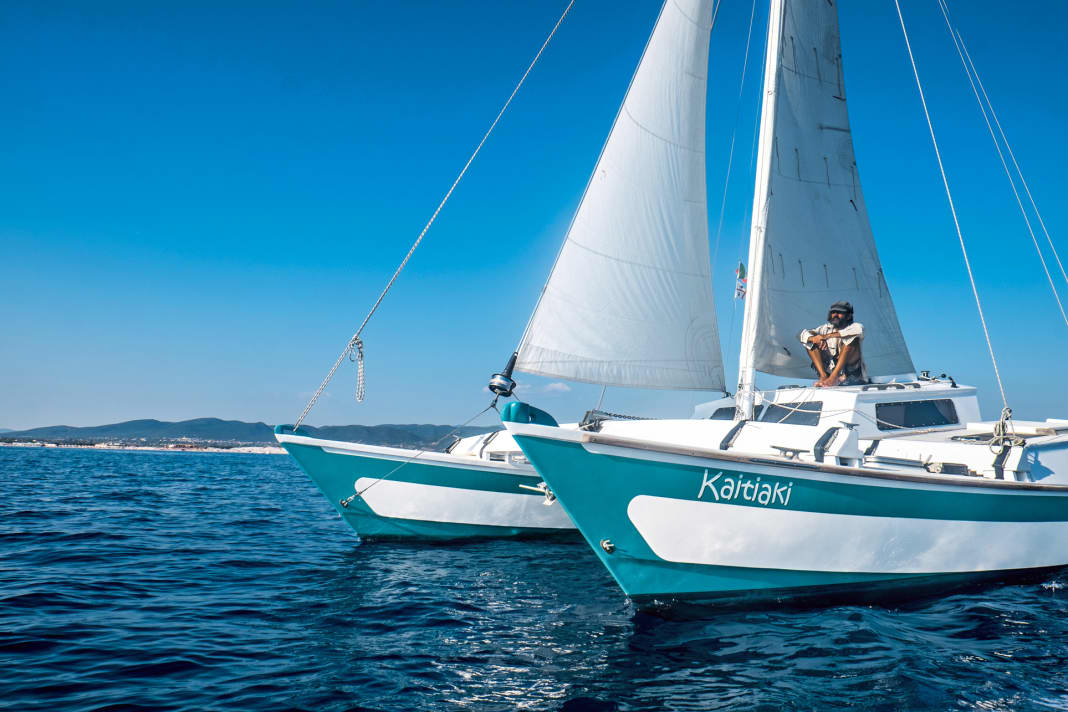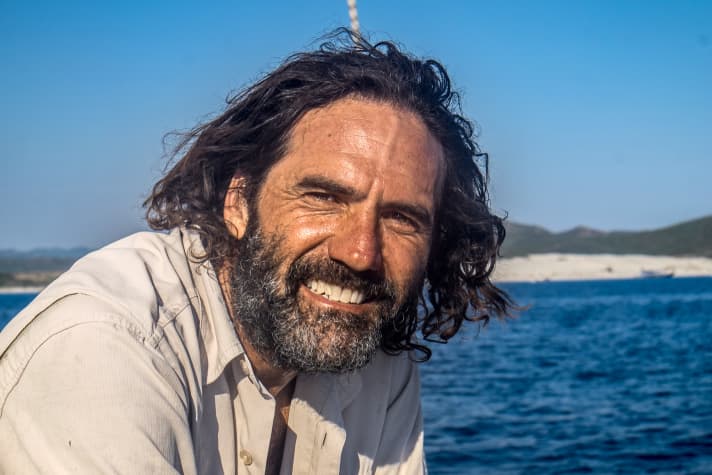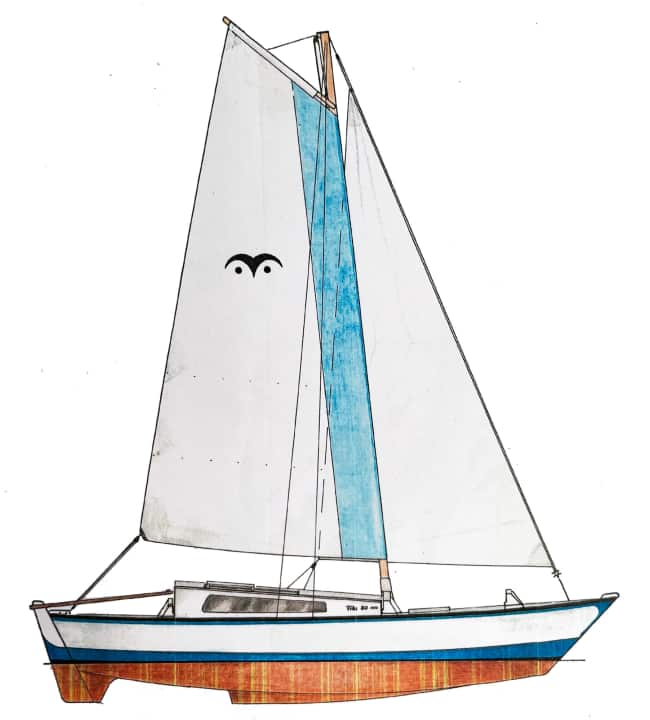





Capital yachts are anchored in the bay of Porto Pino, 90-foot-long sailing villas, mega yachts with Jacuzzi decks and butler service on board. To the left and right are the usual Mediterranean sailing machines. Hardly anything under 60 feet, carbon sails everywhere, hydraulic bathing platforms, stern garages with jet skis and all the bells and whistles. Midsummer reigns over southern Sardinia, the sea a frenzy of turquoise, music blares across the lagoon in the early evening.
At sunset, another vehicle floats into the bay, but it is conspicuously inconspicuous compared to the others. It is minimal and quiet, a small sailing wardrobe, fine lines, flat as a flounder. The boat also stands out in two respects, not only because of its two narrow hulls, but also because of its flag: the Australian national flag flies at the stern. And then there's the skipper. He stands hands-free on a skid at the front, with a peaked cap, sinewy torso, beard and long hair. The small boat turns and drops anchor under sail, as silent as a seagull.
The Tiki 30 is designed to be built by yourself
The man on board unfurls his awning, clears one or two lines and the most important manoeuvre of the day begins: jumping into the warm sea. The small yacht is made for it, the apparently feather-light catamaran floats just half a metre above the water, painted the turquoise colour of the South Seas and with an extremely Polynesian appearance. The hulls are reminiscent of the shape of Tahitian outrigger canoes, the trampolines almost touch the waves, and the white-painted tiller is curved far aft.
However, the most unusual feature of this seaworthy speedster is that, unlike the million-dollar boats, this is a "do it yourself" boat. The catamaran was designed to be built with your own hands - even without being a trained boat builder.
James Wharram, the English pioneer of ocean-going multihulls ( see portrait below ) designed the Tiki 30 in the early nineties. After various other designs by the enterprising sailor - both larger and smaller cats - this was intended to be a throw in the golden mean. A so-called coastal trek design, trailerable, but still made of the material to sail on and even across the oceans. Built to live and travel on. The Tiki 30 is nine metres long, five metres wide and weighs just 1,000 kilograms. A simple, narrow double berth is hidden in each hull, while a flat deckhouse between the hulls provides additional space.
Independence and freedom were the life mottos of Kat designer James Wharram. They characterised his work just as much as the search for particularly simple solutions"
Trampolines fore and aft, storage space in two forecastle boxes, a chart table in the cabin, the mainsail fitted with a short gaff, plus a small furling jib - the Polynesian interpretation of modern sailing is complete: a flat, manoeuvrable yet seaworthy cat that can do pretty much anything - you can even go on safari with it. A fleet of Tiki 30s has already taken to the water on Lake Kariba in Zimbabwe to approach herds of elephants and buffalo. Because of its shallow draught, the quiet stalking on the water, but also because of the space it offers for guests, the cat has often been used as a safari boat in Africa.
An idea entirely in the spirit of James Wharram. The wiry Brit was an outdoorsman and sailing minimalist, an adventurer, free spirit, lateral thinker and the enabler of a thousand crazy ideas. In 1953, he designed his first ocean-going catamaran, the "Tangaroa", making the twin-hulled boat acceptable as a cruising yacht. In Trinidad and Tobago in the 1950s, he sat down with sailing icon Bernard Moitessier to refine his designs and ideas. Above all, his idea of the simplest possible lifestyle on the water captivated many: Freedom and independence were Wharram's motto - even without a big wallet. The Tiki 30 found so many fans for good reason: James Wharram sold over 2,000 blueprints of his mid-range runabout. The sea-loving catamaran pope died in winter 2021. But the cult around his lightweight catamarans continues.
Textile connections replace metal
The next morning, the outgoing Australian skipper invites us on board to sail. The cat floats weightlessly free from its mooring, the sails are quickly set and the vehicle gets underway. Nodding cheerfully, the "Kaitiaki" strolls through the small waves, runs surprisingly high on the wind, tacks, jibes. Mark Seisun, 52, bought the cat second-hand in Sardinia, refurbished it, renewed many of the details and made it fit for purpose himself.
Some design details immediately catch the eye. Loose, simple connections wherever you look: Instead of metal fittings, expensive blocks and elaborate bolting, ropes are the connecting solution in many places - just like in ancient Polynesia, where the early inhabitants of the South Seas knotted almost everything together with coconut fibre to build their boats. The trapeze, on which the forestay is tensioned, was passed through two holes in the tops of the hull with ropes: no screw, no bolt, no jib iron. Only a hand-painted wooden foundation reinforces the sensitive area. "Easy does it," says Seisun, who now knows the cat by heart. "Simple solutions everywhere, that's what makes the design so special."
The same applies to the connection between the two hulls. Wharram swore by beams with flexible contacts in order to minimise the load at the crucial points. The boat should hug the waves - never going against them, but always moving with the sea and its movements through the water. Mark Seisun wanted to renew these important connections. In Sardinia, he sneaked through the garages and looked for old seat belts - now they hold the catamaran's hulls and load-bearing cross struts together: firm and yet flexible enough to enable beautiful, smooth sailing.
The two rudders are suspended in a similar manner, so to speak: with rope loops made of strong, modern rope. No hinges to break, no screws to rust. And to check or replace all the fastenings, all you have to do is steer the cat onto a sandbank, get into shallow water and replace the ropes if necessary. Free fun manoeuvres instead of expensive shipyard visits. Simple. Ingenious. Inexpensive.
Legendary: Wharram's do-it-yourself catamarans
With ideas and solutions of this kind, Wharram catamarans have long since earned a legendary reputation. Over the last 50 years, more than 10,000 Wharram designs of various lengths and sizes have been sold. Self-made catamarans that have now travelled several million nautical miles across the world's oceans. And not one is said to have ever capsized. However, Wharram believed in the philosophy of self-building for other reasons. He once wrote: "In a world of changing values, building your own boat gives you an inner security, it gives you the strength and individuality to live your own life."
Constructing your own boat according to Wharram's plans is like a fast-track boat-building course. Without overly complicated construction phases, without heavy equipment, without utopian materials. It takes 900 to 1,200 hours to build the Tiki 30 yourself. In 2005, designer Wharram estimated the cost of building the cat at 12,000 British pounds, although the sum is of course likely to be considerably higher today.
The cat can be manufactured for 20,000 euros and fitted out for the same amount. The result is an ocean-going boat
Nevertheless, anyone who can build such a handsome and spacious cat for around 20,000 euros is fulfilling a dream - for little money. There is always enough left over for the equipment. With sails, electrics, navigation, personalisation, built-in outboard motor and all equipment, the Tiki 30 costs between 30,000 and 40,000 euros. Brand new. That leaves room to breathe. Leaves room to do what it's all about: setting off and sailing away. Exactly Wharram's philosophy.
A damn great ship!
The cat is built from solid boatbuilding plywood and fibreglass, with plans designed for amateurs. The mast is also made of wood: spruce or Alaskan cedar. You quickly realise how to plan the construction phases, how work steps are carried out and how details fit together. Once the hulls are finished, the connections follow and, if required, the small deckhouse. It looks like a space capsule with two flat berths for adults, plus a chart table, navigation corner, storage space - and a panoramic view of the sea like on a deck saloon yacht.
On the water, the cheerful cat shows all the qualities for which it is so often praised. It starts quickly, sails well and is stable on course. The smaller version, the Tiki 26, has often crossed the Atlantic with these qualities. The Brit Rory McDougall even sailed around the world in an even smaller Tiki 21 from 1991 to 1997. He called his cat "Cooking Fat", an inversion of "Fucking Cat", nothing more than a bitter declaration of love to the adventurous Wharram design. Clearly speaking: a damn great ship!

An Australian in love with water
On board, owner Mark Seisun points high into the sails. Another special feature of the boat: The mainsail rises at the halyard, the gaff is trimmed, with a front zip-fastened canvas pocket completely enclosing the mast - just like a windsurfer's sail. This gives the sail a perfect leading edge, an optimal profile. For the Australian, however, it is by no means just the technical and sailing details that make this boat so special to him. His "Kaitiaki" means more to him. She is his personal oasis of freedom in a cramped, crowded Europe.
Seisun is a water person. He grew up in Sydney, sailing with his father from an early age. A small family yacht stood on the trailer in the garage driveway, always ready for trips on the waters outside the front door. He and his family sailed off, pulling the boat onto the beaches of the islands in the evenings. They slept on the beaches, on the boat, swam, dived, hunted moray eels, parrotfish and snapper while spearfishing. A life in the great Australian freedom. At the age of eleven, with an Investigator 563, they travelled to the Whitsundays, to Hamilton Island, and hid in the mangroves during storms.
His first boat was a Pacific Westerly, which he sailed along the coast off Sydney. This was followed by tours with pick-ups and small boats along the coast, into the wilderness of the Great Barrier Reef and up into the godforsaken Torres Strait, where there are more saltwater crocodiles swimming in the sea than people to be seen on land. Australia - sailing among sharks, corals and tropical magic. And he never wanted to stop being in the water. As an engineer, Seisun later strapped his windsurfing boards to the top of his lorries to whizz through the blue waves even at the most remote construction sites in the bush.
The Tiki 30 is Seisun's Australia in Europe
One day, when he is in his mid-thirties, he takes a huge step. Seisun meets a Swiss woman, they have sons Tayne and Jai - and decide to move to Europe. For Mark Seisun, it is a patent jumping ship to another world. Mountains. Winter. Houses everywhere, people everywhere. A neat idyll, no crocodiles far and wide. Just Switzerland. "It's very beautiful there, no doubt about it," he says. "But I was landlocked - I was suddenly stuck in the country, on dry land."
From Australia, the water man ended up in Switzerland. His escape from dry land is the cat in the Mediterranean
What to do? When he couldn't stand it any longer, he looked around for a boat. A sailing boat. It had to be simple, taste of freedom and remind him a little of his distant homeland. Then he found the Tiki 30 in the classified adverts. The cat was down in Sardinia. Blue sea, hot summers, a season that lasts all year round. He has now owned his "Kaitiaki" for three years. He has refloated it, painted the boat a pretty white and turquoise like the Aarafura Sea, and has already sailed it around Sardinia to the bays, beaches and grottos in the south of the islands. Since then, his "Kaitiaki" has been his escape point. His Australia in Europe.
The dream: back to Australia with the Tiki
Their two sons Tayne and Jai are also on board. They come to Sardinia again and again in the summers, spending time with their dad on the boat. Sailing, sleeping, fishing, cooking, living on the catamaran, on two runners and the large trampolines, just half a metre above the waves. Like in a faraway land, like in the atoll of dreams. But the two are slowly growing up. Training awaits, a career, their own path through life. During these days, the three of them sail across the blue sea together once again, setting off southwards the next morning: 120 nautical miles across to Tunisia. An easy exercise for the Wharram cat. A short transcontinental trip on two runners. The boat glides over the waves at seven knots, light, agile and smooth. Like a dragonfly on the wide open sea, like a bird heading for the sun.
And after that? Mark Seisun, Australian blood in his veins and a very Polynesian vehicle under his feet, looks into the distance, strangely enraptured by the question. "Back to Australia with my Kat? That would be great," he says. Atlantic, Caribbean, Pacific. Or the other way round, across the Indian Ocean. A mighty adventure would await, a huge gulp of freedom. In the spirit of the inventor. James Wharram would say: Do it, Mark - that's exactly why I brought this boat into the world.
Technical data Tiki 30
- Torso length: 9,15 m
- Waterline length: 7,75 m
- Width: 5,00 m
- Depth: 0,65 m
- Weight: 1,0 t
- sail area: 35,8 m²
- Payload:1,0 t
- Construction time: approx. 900 hours
- Building process: Sewing & gluing

The Kat legend James Wharram
James Wharram (1928 to 2021) from Manchester is considered the father of the modern catamaran, although he hated this term and preferred the term twin-hull instead. He attributed his pioneering work in multihull ocean sailing not to himself, but to the German Schwarzenfeld brothers, who were travelling with steel boats in the 1950s - a British understatement. Wharram crossed the Atlantic from west to east in 1959 with the 40-foot-long "Rongo", which he designed and built with the help of ocean legend Bernard Moitessier. The Briton favoured self-construction, and around 10,000 plans of his designs were sold. His Tiki series comprises eight types ranging from 21 to 46 feet.


